Article and photos by Michael Salvarezza and Christopher P. Weaver
© 2016 Eco-Photo Explorers
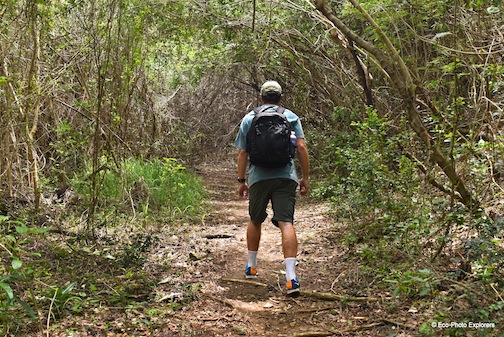
The road seemed almost impassable: deep ruts, numerous potholes, nonexistent markings, very spotty pavement and pools of water were presenting a challenge not only to the suspension on our car but to our spinal cords! We began to question how the local government could even assign a number (route 63) to this road!
We were on the island of St. Croix, a United States territory with a distinctly Caribbean feel. Our destination was the seldom-visited Hams Bluff Lighthouse. After miles of steadily deteriorating road conditions, we arrived at the end of Route 63 and parked in front of the National Guard facility. The rest of the way would be on foot.
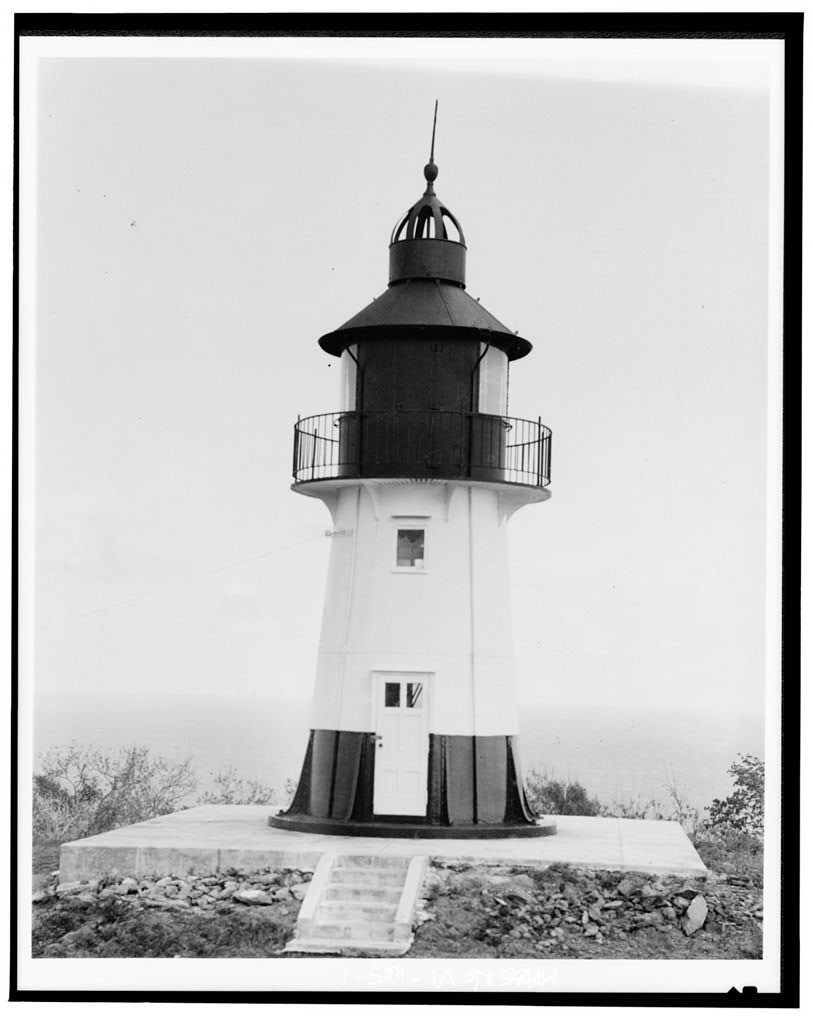
The hike to the Hams Bluff Lighthouse is a moderate one. In the tropical heat and humidity it is important to take water and to take breaks along the way. The trail to the lighthouse is all uphill for about 30 minutes, winding its way through brush, tall grass, and tropical forest. Because the conditions on the trail vary greatly, it’s a good idea to wear sturdy footwear and long pants. Sunscreen, a hat, sunglasses and insect repellent are highly recommended.
Before long, though, the canopy of vegetation gives way to blue sky and this is the sign that you have almost reached the summit of the bluff. Rounding a final turn in the trail, we caught our first glimpse of the Hams Head Lighthouse.
Our hearts dropped.
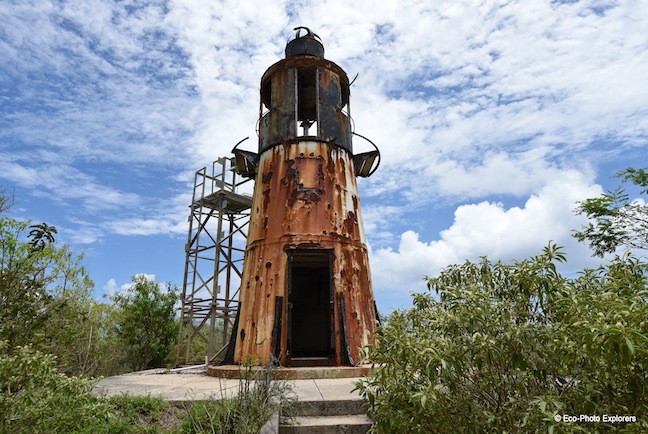
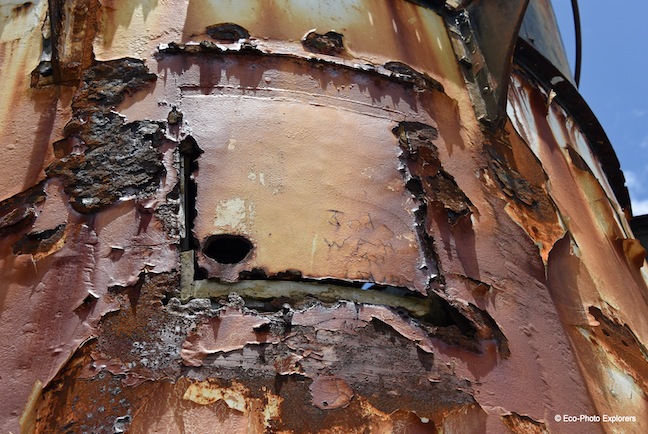
There before us was the rusting hulk of this once handsome and useful lighthouse. Standing on a cement platform, the 35-foot tower stood in the baking sun atop this bluff overlooking the Caribbean Sea and its deteriorating condition was immediately evident. Huge streaks of rust stains ran down its sides, the rails on the cupola were broken in spots and several areas of the tower had completely decayed through to the inside.
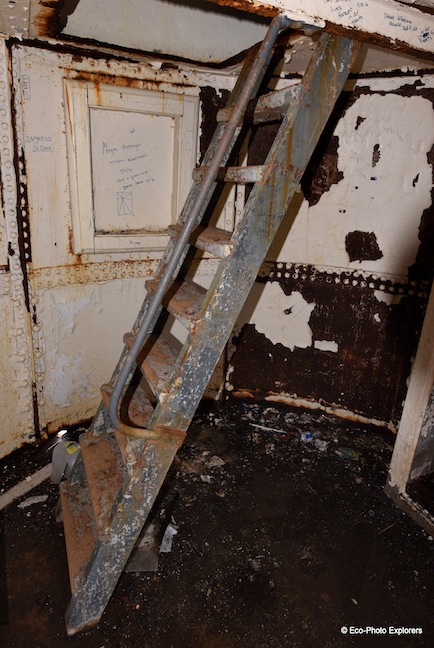
The door was ajar and we could make our way inside to a dank, soggy interior. The floor consisted of a crunchy layer of fallen iron and steel flakes, and the walls were all desecrated with thoughtless graffiti. A short ladder led to the second level of the lighthouse, and once upstairs we were reluctant to walk around for fear of falling through the rapidly crumbling floor. We could see from this level, however, the wonderful views of the sea and the bluff, and could easily imagine the usefulness of this lone sentinel when it was in operation.
The Hams Bluff Lighthouse was built in 1915 by the Danish government, who owned this island at the time, and was originally operated by lighthouse keeper A.L.F.L. Madsen.
The lighthouse was constructed with cast iron on a concrete foundation and was originally painted white with a black cupola. It was built atop the Hams Bluff, which rises to a height of about 360 feet above sea level, to help mariners navigate safely around the west end of the island and into Fredericksted Harbor. Shortly after it was built, the Danish West Indies were sold to the United States. St. Croix, along with St. Thomas and St. John, became United States territories and at this point the U.S. Coast Guard took over operation of the lighthouse. In the mid-1990s, the lighthouse was deactivated.
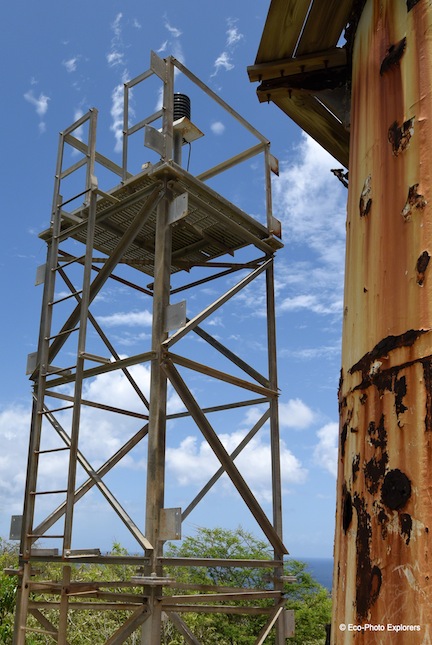
We stood on the bluff with the cooling breeze coming up over the hills from the water. It felt good after our strenuous and sweaty climb to this point. The views of nearby Annaly Bay and Davis Bay were stunning. But we could not shake the melancholy feeling of sadness over the condition of this poor, once proud lighthouse. Clearly it has been deteriorating for years in the harsh salty environment atop the bluff. With every hour of searing tropical sun we could imagine another flake of iron falling off the side of the tower. Neglected, forgotten, abandoned this lighthouse will soon crumble into the soil of the bluff. There have been some efforts to preserve this remnant of history but so far nothing has really resulted in any progress.
Honestly, we wonder if it’s too far gone anyway at this point.
The area surrounding and including the bluff has another, darker component of history that is also fading away into the recesses of time. Maroon Ridge is the geological feature that the area takes its name from, and during the time of Danish ownership of the island, a community of slaves was known to be here in an area the Danes referred to as Maroonberg. According to historical accounts, a particularly brutal form of slavery was operated on St. Croix, with runaway slaves severely and publically beaten and tortured. Runaways often headed for this remote area and used it as a way to leave for Puerto Rico. Thousands fled the plantations in search of freedom, and many would eventually pass through Maroon Ridge. Many were recaptured by the Danes, but many more committed suicide rather than face recapture. Documents indicate that only 300 brave and desperate slaves ever made it to Puerto Rico and to freedom.
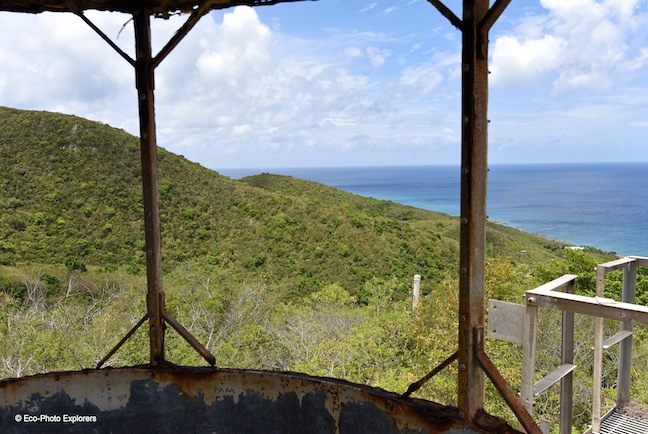
We sat in silence, our thoughts wandering through the pages of the past to imagine a time when lighthouse keepers tended to this lighthouse and mariners depended upon its service. We contemplated the desperation of the runaway slaves who passed through here long before this lighthouse had ever been built. And we were struck by the history that lies embedded in these hills and forests, a history that is fading with each passing year.
We then stood up, bid the lighthouse good bye and began our hike down the bluff and back to our car. Along the way, a tear mixed with our sweat and dropped to the forest floor, a token of our concern for this neglected lighthouse on St. Croix and a measure of our respect for the slaves who passed through these hills. As we walked away, we stole one final glance at the lighthouse that still maintains its dignity despite years of neglect. And we wished it well.
* * * *
U.S. Lighthouse Society News is produced by the U.S. Lighthouse Society to support lighthouse preservation, history, education and research. Please consider joining the U.S. Lighthouse Society if you are not already a member. If you have items of interest to the lighthouse community and its supporters, please email them to candace@uslhs.org.

Candace was the US Lighthouse Society historian from 2016 until she passed away in August 2018. For 30 years, her work involved lighthouse history. She worked with the National Park Service and the Council of American Maritime Museums. She was a noted author and was considered the most knowledgable person on lighthouse information at the National Archives. Books by Candace Clifford include: Women who Kept the Lights: a History of Thirty-eight Female Lighthouse Keepers , Mind the Light Katie, and Maine Lighthouses, Documentation of their Past.


Wonderful & very sad story. Must have originally had a 1st order lens. Any clue where that might have gone? And keeper quarters?
>